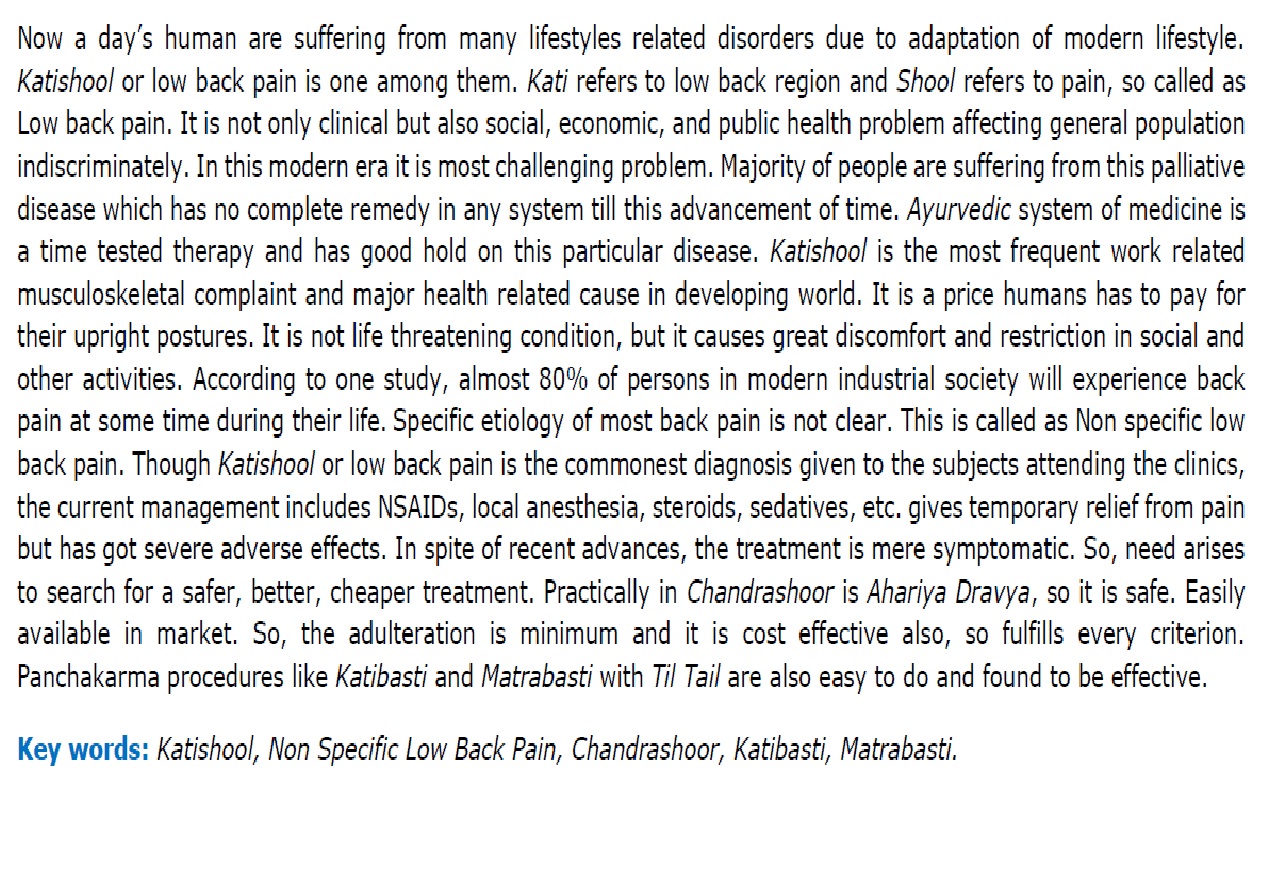Ayurvedic management of Katishool with special reference to Non Specific Low Back Pain : A Case Study
Keywords:
Ayurveda, Katishoola, Katishula, Non specific low back pain, Back ache, Chandrashoor, Katibasti, Matrabasti, Case studyAbstract
Now a day’s human are suffering from many lifestyles related disorders due to adaptation of modern lifestyle. Katishool or low back pain is one among them. Kati refers to low back region and Shool refers to pain, so called as Low back pain. It is not only clinical but also social, economic, and public health problem affecting general population indiscriminately. In this modern era it is most challenging problem. Majority of people are suffering from this palliative disease which has no complete remedy in any system till this advancement of time. Ayurvedic system of medicine is a time tested therapy and has good hold on this particular disease. Katishool is the most frequent work related musculoskeletal complaint and major health related cause in developing world. It is a price humans has to pay for their upright postures. It is not life threatening condition, but it causes great discomfort and restriction in social and other activities. According to one study, almost 80% of persons in modern industrial society will experience back pain at some time during their life. Specific etiology of most back pain is not clear. This is called as Non specific low back pain. Though Katishool or low back pain is the commonest diagnosis given to the subjects attending the clinics, the current management includes NSAIDs, local anesthesia, steroids, sedatives, etc. gives temporary relief from pain but has got severe adverse effects. In spite of recent advances, the treatment is mere symptomatic. So, need arises to search for a safer, better, cheaper treatment. Practically in Chandrashoor is Ahariya Dravya, so it is safe. Easily available in market. So, the adulteration is minimum and it is cost effective also, so fulfills every criterion. Panchakarma procedures like Katibasti and Matrabasti with Til Tail are also easy to do and found to be effective.
Downloads
References
Medegar R., Effect Of Gandharva Hastadi Taila Virechan And Trivrut Lehya Virechana In Trika Shoola w.s.r.t. Low Back Pain – Comparative Study, 2011,pg 2
Bandil V., Sharma R., A clinical evaluation of Rasnadi Guggul and Katibasti in Katishool w.s.r. to Lumbo-Sacral disorders, Journal of Ayurveda, vol2, No.2, Apr-Jun 2008, Pg50-58.
Sampat D., Chandaliya S., Comparative clinical trial between Dhanyamla Sahit and Rahit Erandamoola (Ricinus communis Linn) Basti in Katigat Vata, International Ayurvedic Medical Journal, ISSN:2320 5091, vol 3, issue 5, may 2015,pg 1441-1448.
Maheshwari J, Essential orthopedics, edition 3, chapter 30, pg 261
Kale S., Pawar P. Therapeutic action of Chaturbeej Churna in Katishool, Journal of Sanskrit Samhita Siddhanta, 2017, volume 2, Apr-Jun, ISSN:2454-3926,Pg32-35.
Trikamji Y, Charaka Samhita with the Ayurveda Dipika commentary by Chakrapanidatta, Chaukhamba Surbharati Prakashan, Varanasi, edition 2008, Sutrasthana, Chapter 25, Verse 40, p.n.131.
Billore K, Yelne M., et al. Database on Medicinal Plants used in Ayurveda: Volume 7, CCRAS, New Delhi, 2005, Chandrashoor - Lepidium sativum, p.54
https://www.easyayurveda.com/2011/02/24/sesame-and-sesame-oil-benefits-total-ayurveda-details/















